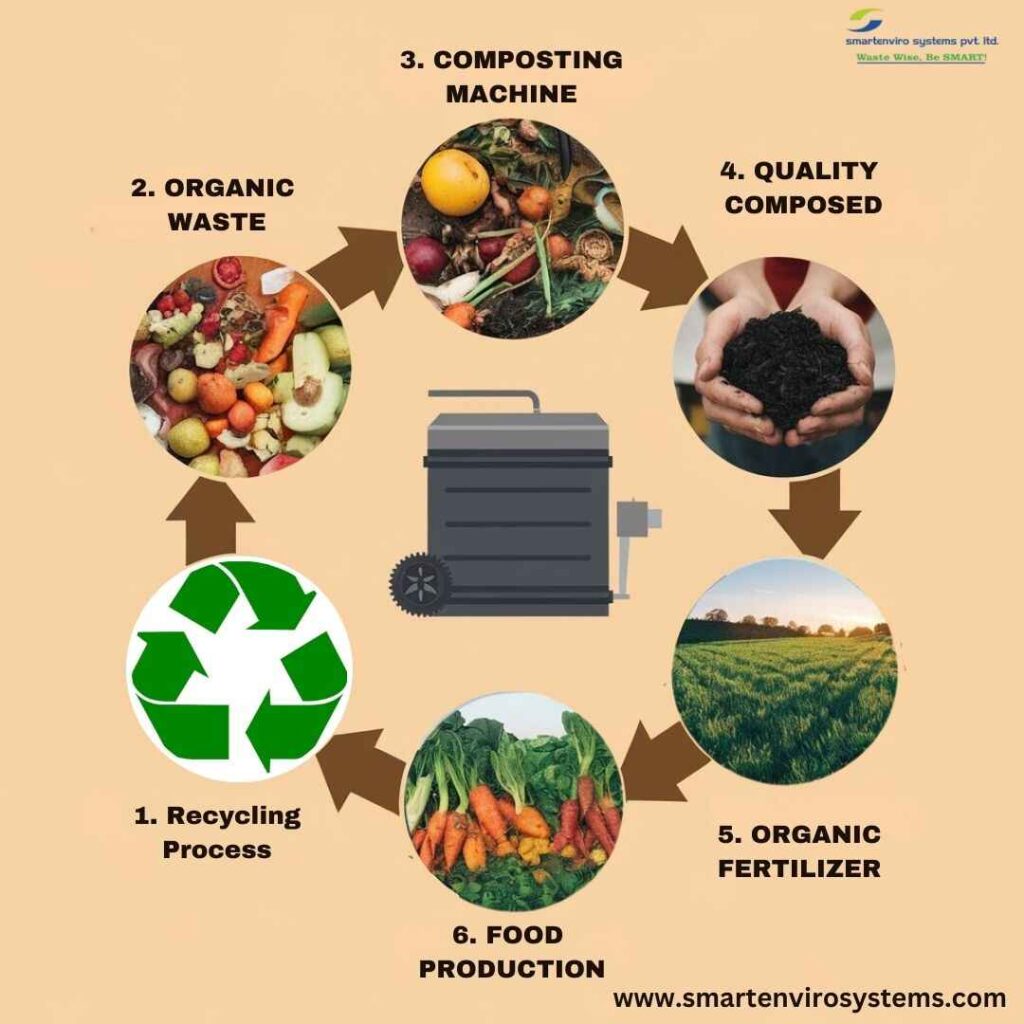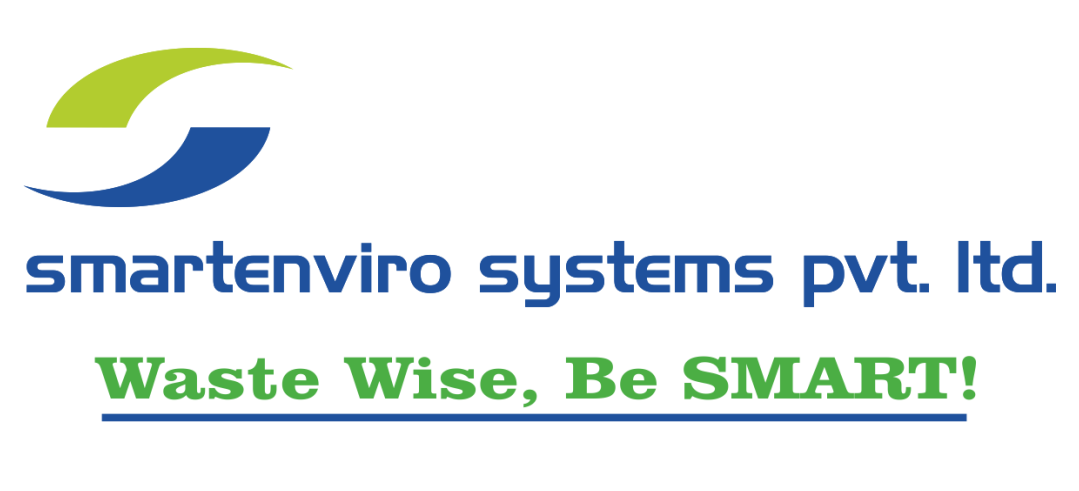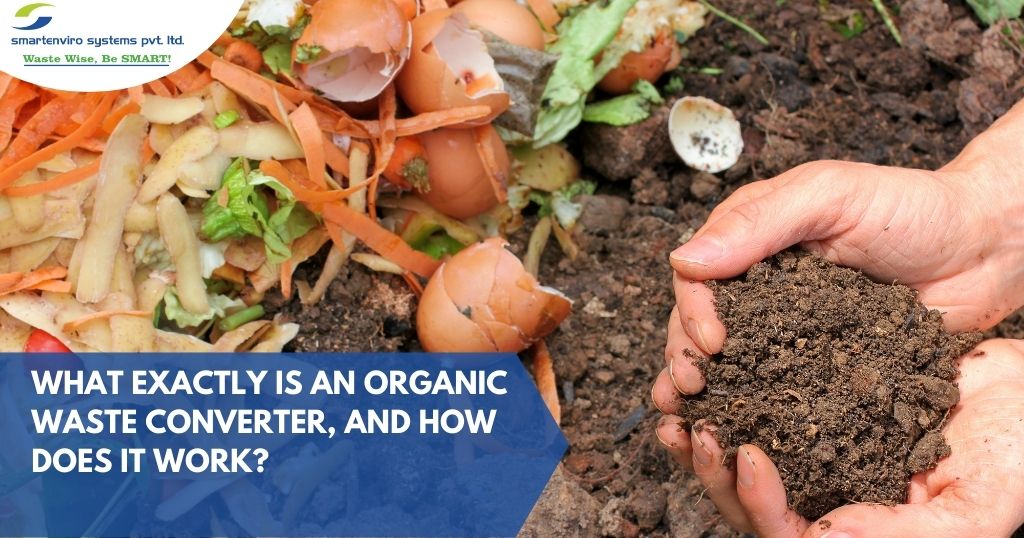The Organic Waste Converter Machine is a system that helps the composting process. Composting is bacteria and fungi decomposing organic waste in the presence of oxygen to produce an organic fertiliser known as compost. Composting has become much easier with the invention of this machine.
This machine composts a large quantity of biodegradable solid waste. Composting was done at home before its creation, and it took a long time to produce the results.
Organic waste converter turns organic waste such as vegetables, meat, bakery trash, leaves, fruits and fruit skins, and flowers into helpful compost that may be utilized in organic farming. Composters and converters are two terms that are often used together.
Some converters can be used for both solid and liquid organic waste treatment and recycling. Converters are self-contained systems that may execute several tasks, including waste separation, shredding or crushing, filtering, dewatering, mixing, and curing.
The technology has found use in several industries that create organic waste due to the vast range of functions available on converters. The organic waste converter technology benefits residential estates, restaurants, food canteens, shopping malls, educational institutes, municipal corporations, vegetable markets, fish markets, military bases, naval bases, and temples.
When composting waste, it’s essential to remember that the carbon-to-nitrogen ratio needs to be managed appropriately. Composting will take longer if there is a lot of carbon, and if there is too much nitrogen, the process will stink.
The moisture content and oxygen concentration of the pile are other crucial considerations. When composting, all of these considerations must be factored in. Composting by hand is often a difficult task. As a result, an organic waste composter may be considered.
Organic waste converter models
Mechanical composting is the most efficient way to dispose of garbage in cities. A built-in shredder and a cylindrical container are included in the design. The churning method breaks down trash by crushing and mixing it simultaneously, reducing volume and speeding up pre-decomposition. The Organic Waste Composter’s heating element provides extra heat to maximize the action of the microorganisms and speed up the composting process, resulting in ready-to-use compost.
KEY FEATURES
- Built-in shredder with the ergonomic position
- Quiet and odorless operating
- The composting process takes 3–4 days.
- Designed to meet the most stringent safety requirements
- A single machine may handle the whole composting process.
- The VFD system regulates and maintains consistent mixing.
Covered Aerated Static Pile Composter
Windrow composting has been enhanced with aerated static pile composting. The waste is piled in rows here as well. However, an air pipe is installed beneath the table to supplement oxygen supply and avoid creating anaerobic conditions.Typically, a blower is used to pull air through the pile. The blower capacity is determined by the decaying waste’s defined oxygen demand characteristics.

The airflow rates can be changed depending on the rotting stage, and the temperature reached in the waste’s core.To do this, suitable probes may be inserted into the piles, then linked to a microcontroller to control the blower.
KEY FEATURES
- Rapid Biodegradation Process Control
- Ideal for facilities that process wet materials
- Suitable for large volumes of feedstocks
- ASP facilities can be indoor windrow composting operations or outdoor windrow composting operations.
SMART Drum Composter
The machine is built on the concept of combining a whole composting system into a single unit. The waste is initially fed into a shredding mechanism, which decreases the size of the waste and increases the surface area available to microorganisms for rapid composting.
Because aerobic composting is an exothermic process, it creates heat, which aids in the removal of moisture through evaporation, resulting in dry, ready-to-use compost in a matter of days. From the discharge end, the compost may be discharged at consistent levels. The composting chamber’s air exchanges guarantee that there is enough air available for aerobic composting.
KEY FEATURES
- Shredding mechanism that is ergonomically positione
- Quiet and odorless operating
- The composting process takes 10–12 days.
- Highest safety standards were used in the design.
- In a single machine, a complete composting system
The machine comprises a shredder and a mixer for mixing and shredding waste into uniform sizes simultaneously. The machine also incorporates the composting culture and dry materials such as dried leaves, sawdust, and other dry materials into the shredded waste for moisture absorption.
- The operation is essential and straightforward.
- A 10- to 12-day composting cycle is required
- Safety features built-in
- Pre-programmed batch time on the control panel
The Smart Composter processes the following bio wastes:
- Household kitchen food waste
- Vegetables
- Vegetable waste
- Fruits and fruit skins
- Cooked or uncooked meat
- Bones/egg shells
- Bread/bakery items
- All cooked food waste
- Street-sweeping leaves
- Leaves and tree branches -(bigger branches to be broken to small pieces)
- Flowers
- Temple waste
The Smart Composter has the following features over other converters, hence it sets itself apart from the rest:
- Its composting process is continuous.
- Its composting capacity is 50 kgs per day.
- It is closed from all sides and is free of pathogens.
- It has an in-built curing system.
- Its manpower requirement is negligible, and it can also be operated by unskilled personnel.
- Its operating cost is about 50% of other types of converters.
- Once the waste is deposited in it, there is no need for further handling.
- Its enclosure helps to preserve heat.
- There is an odor filter available as an additional accessory.
- The composting process is electronically monitored and controlled.
- Its space requirement is low because all the processes happen in the same unit.
- The temperature inside the unit is high and kills the pathogens.
- It creates ambiance because the food waste deposited is processed into compost with a pleasant smell.
The following are components included with the Smart Composter accelerator:
- An appropriate exhaust blower with an activated carbon filter is in-built in the converter.
- A panel board.
- An operations manual.
The following are the operating costs associated with the Smart Composter accelerator:
- The electricity consumed monthly depends on the moisture content of the waste.
- A one-time cost is included in the monthly quote for composting culture.
- Manpower input is normally a nil factor because manual operations only entail the loading of the organic wastes and replacing the compost barrel.
Conclusion:
The technique used in organic waste converters is ecologically beneficial. This technique is a viable alternative to landfill dumping and incineration as means of organic waste disposal. Converters minimize pollutants and generate compost, which is a valuable end product.
Composting systems and capacity differ across converters. In India, Smart Enviro Systems is the leading manufacturer of food waste composting machine. Our employees’ willingness to contribute to environmentally sustainable business ideas by recycling waste drives our success.
Frequently Asked Questions (FAQs) on Organic Waste Converters in 2025
1. What is the main purpose of an Organic Waste Converter (OWC) in 2025?
In 2025, Organic Waste Converters (OWCs) play a crucial role in sustainable waste management by converting food scraps, garden waste, and other organic materials into nutrient-rich compost. With rising environmental concerns, OWCs help reduce waste volume by up to 80%, minimize pollution, and support eco-friendly initiatives like urban farming and zero-waste policies.
2. How do Organic Waste Converters help in sustainable waste management?
OWCs use advanced composting technology to efficiently break down organic waste, preventing landfill overflow and methane emissions. In 2025, new smart monitoring features allow real-time tracking of composting efficiency. These converters now integrate with AI-powered waste management systems, making them ideal for residential, commercial, and municipal applications looking to optimize their sustainability efforts.
3. What types of waste can be processed in an Organic Waste Converter?
OWCs can handle various organic waste types, including vegetable scraps, meat, bakery items, fruit peels, cooked food, leaves, and flowers. However, they cannot process plastics, metals, or hazardous waste. In 2025, some models now support enhanced processing of biodegradable packaging, aligning with the growing trend of sustainable food packaging solutions.
4. How do Organic Waste Converters compare to traditional waste disposal methods?
Unlike landfill dumping and incineration, OWCs in 2025 are more energy-efficient, reducing carbon footprints while producing valuable compost. Many modern models come equipped with IoT-based monitoring systems for automated control. Their odor-free, low-maintenance operation and seamless integration with smart city waste management programs make them superior to traditional disposal methods.
5. What are the key benefits of using an Organic Waste Converter?
OWCs provide several benefits, including waste volume reduction, odor-free operation, and a continuous composting process. In 2025, newer models require even less maintenance, feature AI-driven efficiency tracking, and integrate with sustainable urban farming initiatives. The compost they produce is highly enriched, making it perfect for regenerative agriculture and climate-friendly soil restoration.
6. Are there different models of Organic Waste Converters available?
Yes, various OWC models are available, catering to different waste processing needs. Some models focus on high-capacity composting, while others prioritize space efficiency and rapid processing. In 2025, new compact and modular OWCs are gaining popularity, especially in urban settings where space constraints demand more efficient and adaptable waste management solutions.



